
History of Miami, Florida
Encyclopedia
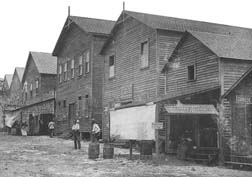
Miami, Florida
Miami is a city located on the Atlantic coast in southeastern Florida and the county seat of Miami-Dade County, the most populous county in Florida and the eighth-most populous county in the United States with a population of 2,500,625...
, Florida
Florida
Florida is a state in the southeastern United States, located on the nation's Atlantic and Gulf coasts. It is bordered to the west by the Gulf of Mexico, to the north by Alabama and Georgia and to the east by the Atlantic Ocean. With a population of 18,801,310 as measured by the 2010 census, it...
would later be founded by Europe
Europe
Europe is, by convention, one of the world's seven continents. Comprising the westernmost peninsula of Eurasia, Europe is generally 'divided' from Asia to its east by the watershed divides of the Ural and Caucasus Mountains, the Ural River, the Caspian and Black Seas, and the waterways connecting...
ans was inhabited for more than a thousand years by the Tequesta
Tequesta
The Tequesta Native American tribe, at the time of first European contact, occupied an area along the southeastern Atlantic coast of Florida...
s. Pedro Menéndez de Avilés
Pedro Menéndez de Avilés
Pedro Menéndez de Avilés was a Spanish admiral and explorer, best remembered for founding St. Augustine, Florida in 1565. This was the first successful Spanish foothold in La Florida and remained the most significant city in the region for several hundred years. St...
and his men first visited and claimed the area around Miami for Spain
Spanish Empire
The Spanish Empire comprised territories and colonies administered directly by Spain in Europe, in America, Africa, Asia and Oceania. It originated during the Age of Exploration and was therefore one of the first global empires. At the time of Habsburgs, Spain reached the peak of its world power....
in 1566. A Spanish mission
Mission (station)
A religious mission or mission station is a location for missionary work.While primarily a Christian term, the concept of the religious "mission" is also used prominently by the Church of Scientology and their Scientology Missions International....
was established one year later. Fort Dallas
Fort Dallas
Fort Dallas is a urban park in the Lummus Park Historic District of Miami, Florida, just west of Downtown. It once acted as a military base during the Seminole Wars, located on the banks of the Miami River in what is now Downtown, Miami, Florida, United States....
was built in 1836 and functioned as a military base during the Second Seminole War.
The Miami area was better known as “Biscayne Bay Country” in the early years of its growth. The few published accounts from that period describe the area as a wilderness that held much promise. The area was also characterized as “one of the finest building sites in Florida.” However, the Great Freeze
Great Freeze
The Great Freeze refers to the winter of 1894-1895, especially in Florida where the brutally cold weather destroyed much of the nation's citrus crop. It was also known for wiping out the Royal Palm tree from central Florida.-Weather Records:...
of 1894 changed all that, and the crops of the Miami area were the only ones in Florida that survived. Julia Tuttle
Julia Tuttle
Julia DeForest Tuttle, was an entrepreneur, citrus farmer and businesswoman who was largely responsible for, and the original owner of, the land upon which Miami, Florida, was built...
, a local citrus
Citrus
Citrus is a common term and genus of flowering plants in the rue family, Rutaceae. Citrus is believed to have originated in the part of Southeast Asia bordered by Northeastern India, Myanmar and the Yunnan province of China...
grower, convinced Henry Flagler, a railroad tycoon, to expand his Florida East Coast Railroad to Miami. On July 28, 1896, Miami was officially incorporated as a city with a population of just over 300.
Miami prospered during the 1920s but weakened after the collapse of the Florida land boom of the 1920s
Florida land boom of the 1920s
The Florida land boom of the 1920s was Florida's first real estate bubble, which burst in 1925, leaving behind entire new cities and the remains of failed development projects such as Aladdin City in south Miami-Dade County and Isola di Lolando in north Biscayne Bay...
, the 1926 Miami Hurricane
1926 Miami Hurricane
The 1926 Miami hurricane was a Category 4 hurricane that devastated Miami in September 1926. The storm also caused significant damage in the Florida Panhandle, the U.S. state of Alabama, and the Bahamas...
and the Great Depression
Great Depression
The Great Depression was a severe worldwide economic depression in the decade preceding World War II. The timing of the Great Depression varied across nations, but in most countries it started in about 1929 and lasted until the late 1930s or early 1940s...
in the 1930s. When World War II
World War II
World War II, or the Second World War , was a global conflict lasting from 1939 to 1945, involving most of the world's nations—including all of the great powers—eventually forming two opposing military alliances: the Allies and the Axis...
began, Miami, well-situated due to its location on the southern coast of Florida, played an important role in the battle against German submarines
U-boat
U-boat is the anglicized version of the German word U-Boot , itself an abbreviation of Unterseeboot , and refers to military submarines operated by Germany, particularly in World War I and World War II...
. The war helped to expand Miami's population to almost half a million. After Fidel Castro
Fidel Castro
Fidel Alejandro Castro Ruz is a Cuban revolutionary and politician, having held the position of Prime Minister of Cuba from 1959 to 1976, and then President from 1976 to 2008. He also served as the First Secretary of the Communist Party of Cuba from the party's foundation in 1961 until 2011...
rose to power in 1959, many Cuba
Cuba
The Republic of Cuba is an island nation in the Caribbean. The nation of Cuba consists of the main island of Cuba, the Isla de la Juventud, and several archipelagos. Havana is the largest city in Cuba and the country's capital. Santiago de Cuba is the second largest city...
ns emigrated to Miami, further increasing the population. In the 1980s and 1990s, various crises struck South Florida, among them the Arthur McDuffie
Arthur McDuffie
Arthur McDuffie was an African American who died as a result of injuries suffered at the hands of five white Miami-Dade police officers after a traffic stop was conducted. He had led the officers on a high-speed chase on his motorcycle, and was driving with a suspended license. The officers were...
beating and the subsequent riot, drug wars, Hurricane Andrew
Hurricane Andrew
Hurricane Andrew was the third Category 5 hurricane to make landfall in the United States, after the Labor Day Hurricane of 1935 and Hurricane Camille in 1969. Andrew was the first named storm and only major hurricane of the otherwise inactive 1992 Atlantic hurricane season...
, and the Elián González
Elián González
The custody and immigration status of a young Cuban boy, Elián González , was at the center of a heated 2000 controversy involving the governments of Cuba and the United States, González's father, Juan Miguel González Quintana, González's other relatives in Miami, Florida, and in Cuba, and Miami's...
uproar. Miami remains a major international financial and cultural center.
Early settlement
The earliest evidence of Native American settlement in the Miami region came from about 10,000 years ago. The region was filled with pine and hardwood forests and was home to plenty of deerWhite-tailed Deer
The white-tailed deer , also known as the Virginia deer or simply as the whitetail, is a medium-sized deer native to the United States , Canada, Mexico, Central America, and South America as far south as Peru...
, bear
American black bear
The American black bear is a medium-sized bear native to North America. It is the continent's smallest and most common bear species. Black bears are omnivores, with their diets varying greatly depending on season and location. They typically live in largely forested areas, but do leave forests in...
and wild fowl
Fowl
Fowl is a word for birds in general but usually refers to birds belonging to one of two biological orders, namely the gamefowl or landfowl and the waterfowl...
. The first inhabitants settled on the banks of the Miami River
Miami River (Florida)
The Miami River is a river in the United States state of Florida that drains out of the Everglades and runs through the Downtown and the city of Miami. The long river flows from the terminus of the Miami Canal at Miami International Airport to Biscayne Bay...
. The main villages were on the northern banks of the river. The early Native Americans created a variety of weapons and tools from shells.
The inhabitants of the Miami area when the first Europeans visited were the Tequesta
Tequesta
The Tequesta Native American tribe, at the time of first European contact, occupied an area along the southeastern Atlantic coast of Florida...
people, who controlled an area covering much of southeastern Florida, including what is now Miami-Dade County
Miami-Dade County, Florida
Miami-Dade County is a county located in the southeastern part of the state of Florida. As of 2010 U.S. Census, the county had a population of 2,496,435, making it the most populous county in Florida and the eighth-most populous county in the United States...
, Broward County
Broward County, Florida
-2000 Census:As of the census of 2000, there were 1,623,018 people, 654,445 households, and 411,645 families residing in the county. The population density was 1,346 people per square mile . There were 741,043 housing units at an average density of 615 per square mile...
, and the southern parts of Palm Beach County
Palm Beach County, Florida
Palm Beach County is the largest county in the state of Florida in total area, and third in population. As of 2010, the county's estimated population was 1,320,134, making it the twenty-eighth most populous in the United States...
. The Tequesta Indians fished, hunted, and gathered the fruit and roots of plants for food, but did not practice any form of agriculture. They buried the small bones of the deceased, but put the larger bones in a box for the village people to see. The Tequesta are credited with making the Miami Circle
Miami Circle
The Miami Circle, also known as The Miami River Circle, Brickell Point, or The Miami Circle at Brickell Point Site, is an archaeological site in Downtown Miami, Florida...
.
1500s to 1700s: Early Spanish settlement
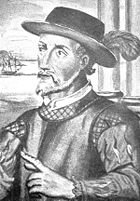
Juan Ponce de León
Juan Ponce de León was a Spanish explorer. He became the first Governor of Puerto Rico by appointment of the Spanish crown. He led the first European expedition to Florida, which he named...
was the first European man to see the Miami area by sailing into Biscayne Bay
Biscayne Bay
Biscayne Bay is a lagoon that is approximately 35 miles long and up to 8 miles wide located on the Atlantic coast of South Florida, United States. It is usually divided for purposes of discussion and analysis into three parts: North Bay, Central Bay, and South Bay. Its area is...
. He wrote in his journal that he reached Chequescha, which was Miami's first recorded name. It is unknown whether or not he came ashore and made contact with the natives. Pedro Menéndez de Avilés
Pedro Menéndez de Avilés
Pedro Menéndez de Avilés was a Spanish admiral and explorer, best remembered for founding St. Augustine, Florida in 1565. This was the first successful Spanish foothold in La Florida and remained the most significant city in the region for several hundred years. St...
and his men made the first recorded landing when they visited the Tequesta settlement in 1566 while looking for Avilés' missing son, who was shipwrecked a year earlier. Spanish soldiers led by Father Francisco Villareal built a Jesuit
Society of Jesus
The Society of Jesus is a Catholic male religious order that follows the teachings of the Catholic Church. The members are called Jesuits, and are also known colloquially as "God's Army" and as "The Company," these being references to founder Ignatius of Loyola's military background and a...
mission at the mouth of the Miami River a year later but it was short-lived. By 1570, the Jesuits decided to look for more willing subjects outside of Florida. After the Spaniards left, the Tequesta Indians were left to fend themselves from European-introduced diseases like smallpox
Smallpox
Smallpox was an infectious disease unique to humans, caused by either of two virus variants, Variola major and Variola minor. The disease is also known by the Latin names Variola or Variola vera, which is a derivative of the Latin varius, meaning "spotted", or varus, meaning "pimple"...
. Wars with other tribes greatly weakened their population, and they were easily defeated by the Creek Indians in battles. By 1711, the Tequesta sent a couple of local chiefs to Havana
Havana
Havana is the capital city, province, major port, and leading commercial centre of Cuba. The city proper has a population of 2.1 million inhabitants, and it spans a total of — making it the largest city in the Caribbean region, and the most populous...
, Cuba
Cuba
The Republic of Cuba is an island nation in the Caribbean. The nation of Cuba consists of the main island of Cuba, the Isla de la Juventud, and several archipelagos. Havana is the largest city in Cuba and the country's capital. Santiago de Cuba is the second largest city...
to ask if they could migrate there. The Cubans sent two ships to help them, but Spanish illnesses struck and most of the Indians died. The Spaniards sent another mission to Biscayne Bay in 1743, where they built a fort and church. The missionary priests proposed a permanent settlement, where the Spanish settlers would raise food for the soldiers and American Indians. However, the proposal was rejected as impractical and the mission was withdrawn before the end of the year.
1700s to 1800s: Early non-Spanish settlement
Samuel Touchett received a land grantLand grant
A land grant is a gift of real estate – land or its privileges – made by a government or other authority as a reward for services to an individual, especially in return for military service...
from the British
Kingdom of Great Britain
The former Kingdom of Great Britain, sometimes described as the 'United Kingdom of Great Britain', That the Two Kingdoms of Scotland and England, shall upon the 1st May next ensuing the date hereof, and forever after, be United into One Kingdom by the Name of GREAT BRITAIN. was a sovereign...
government of 20000 acres (80.9 km²) in the Miami area in 1766. The grant was surveyed
Surveying
See Also: Public Land Survey SystemSurveying or land surveying is the technique, profession, and science of accurately determining the terrestrial or three-dimensional position of points and the distances and angles between them...
by Bernard Romans
Bernard Romans
Bernard Romans was a Dutch-born American navigator, surveyor, cartographer, naturalist, engineer, soldier, promoter and writer. His best known work, A Concise Natural History of East and West Florida, published in 1775, is a valuable source of information about the Floridas during the period of...
in 1772. A condition for making the grant permanent was that at least one white settler
Settler
A settler is a person who has migrated to an area and established permanent residence there, often to colonize the area. Settlers are generally people who take up residence on land and cultivate it, as opposed to nomads...
had to live on the grant for every 100 acre (0.404686 km²) of land. While Touchett wanted to place a plantation
Plantation (settlement or colony)
Plantation was an early method of colonization in which settlers were "planted" abroad in order to establish a permanent or semi-permanent colonial base. Such plantations were also frequently intended to promote Western culture and Christianity among nearby indigenous peoples, as can be seen in the...
on the grant, he was having financial problems and never was able to develop it.
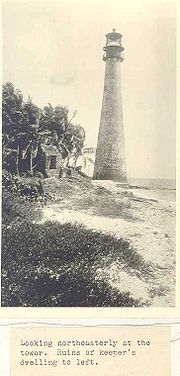
Minorca
Min Orca or Menorca is one of the Balearic Islands located in the Mediterranean Sea belonging to Spain. It takes its name from being smaller than the nearby island of Majorca....
n survivor of the New Smyrna colony, moved to Key Biscayne
Key Biscayne
Key Biscayne is an island located in Miami-Dade County, Florida, United States, between the Atlantic Ocean and Biscayne Bay. It is the southernmost of the barrier islands along the Atlantic coast of Florida, and lies south of Miami Beach and southeast of Miami...
to meet the terms of his Royal Grant for the island. Although he returned with his family to St. Augustine
St. Augustine, Florida
St. Augustine is a city in the northeast section of Florida and the county seat of St. Johns County, Florida, United States. Founded in 1565 by Spanish explorer and admiral Pedro Menéndez de Avilés, it is the oldest continuously occupied European-established city and port in the continental United...
after six months, he left a caretaker behind on the island. On a trip to the island in 1803, Fornells had noted the presence of squatters
Squatting
Squatting consists of occupying an abandoned or unoccupied space or building, usually residential, that the squatter does not own, rent or otherwise have permission to use....
on the mainland across Biscayne Bay from the island. In 1825 U.S. Marshal
United States Marshals Service
The United States Marshals Service is a United States federal law enforcement agency within the United States Department of Justice . The office of U.S. Marshal is the oldest federal law enforcement office in the United States; it was created by the Judiciary Act of 1789...
Waters Smith visited the Cape Florida Settlement (which was on the mainland) and conferred with squatters who wanted to obtain title to the land they were occupying.
People came from the Bahamas
Bahamian American
Bahamian Americans are citizens or residents of the United States of Bahamian ancestry. The United States Census of 2000 counted 31,984 people of Bahamian ancestry.-Communities:...
and the Keys
Florida Keys
The Florida Keys are a coral archipelago in southeast United States. They begin at the southeastern tip of the Florida peninsula, about south of Miami, and extend in a gentle arc south-southwest and then westward to Key West, the westernmost of the inhabited islands, and on to the uninhabited Dry...
to South Florida to hunt for treasure from the ships that ran aground on the treacherous Great Florida reef. Some accepted Spanish land offers along the Miami River
Miami River (Florida)
The Miami River is a river in the United States state of Florida that drains out of the Everglades and runs through the Downtown and the city of Miami. The long river flows from the terminus of the Miami Canal at Miami International Airport to Biscayne Bay...
. At about the same time, the Seminole
Seminole
The Seminole are a Native American people originally of Florida, who now reside primarily in that state and Oklahoma. The Seminole nation emerged in a process of ethnogenesis out of groups of Native Americans, most significantly Creeks from what is now Georgia and Alabama, who settled in Florida in...
Indians arrived along with a group of runaway slaves. In 1825, the Cape Florida Light
Cape Florida Light
The Cape Florida Light is a lighthouse on Cape Florida at the south end of Key Biscayne in Miami-Dade County, Florida. It was built in 1825 and operated, with interruptions, until 1878, when it was replaced by the Fowey Rocks lighthouse. The lighthouse was put back into use in 1978...
house was built on nearby Key Biscayne
Key Biscayne
Key Biscayne is an island located in Miami-Dade County, Florida, United States, between the Atlantic Ocean and Biscayne Bay. It is the southernmost of the barrier islands along the Atlantic coast of Florida, and lies south of Miami Beach and southeast of Miami...
to warn passing ships of the dangerous reefs.
In the 1830s, Richard Fitzpatrick
Richard FitzPatrick
General Richard FitzPatrick , styled The Honourable from birth, was an Anglo-Irish soldier, wit, poet, Whig politician and ‘sworn brother’ of the illustrious statesman of Charles James Fox...
bought land on the Miami River from the Bahamians, becoming one of the first and most successful of the permanent white settlers. He operated a successful plantation with slave labor where he cultivated sugarcane
Sugarcane
Sugarcane refers to any of six to 37 species of tall perennial grasses of the genus Saccharum . Native to the warm temperate to tropical regions of South Asia, they have stout, jointed, fibrous stalks that are rich in sugar, and measure two to six metres tall...
, banana
Banana
Banana is the common name for herbaceous plants of the genus Musa and for the fruit they produce. Bananas come in a variety of sizes and colors when ripe, including yellow, purple, and red....
s, maize
Maize
Maize known in many English-speaking countries as corn or mielie/mealie, is a grain domesticated by indigenous peoples in Mesoamerica in prehistoric times. The leafy stalk produces ears which contain seeds called kernels. Though technically a grain, maize kernels are used in cooking as a vegetable...
, and tropical fruit. Fort Dallas
Fort Dallas
Fort Dallas is a urban park in the Lummus Park Historic District of Miami, Florida, just west of Downtown. It once acted as a military base during the Seminole Wars, located on the banks of the Miami River in what is now Downtown, Miami, Florida, United States....
was located on Fitzpatrick’s plantation on the north bank of the river.
The area was affected by the Second Seminole War
Second Seminole War
The Second Seminole War, also known as the Florida War, was a conflict from 1835 to 1842 in Florida between various groups of Native Americans collectively known as Seminoles and the United States, part of a series of conflicts called the Seminole Wars...
, where Major William S. Harney
William S. Harney
William Selby Harney was a cavalry officer in the U.S. Army during the Mexican-American War and the Indian Wars. He was born in what is today part of Nashville, Tennessee but at the time was known as Haysborough....
led several raids against the Indians. Most non-Indian residents were soldiers stationed at Fort Dallas. It was the most devastating Indian war in American history, causing almost a total loss of population in the Miami area. The Cape Florida lighthouse was burned by Seminoles in 1836 and was not repaired until 1846.
After the Second Seminole War ended in 1842, Fitzpatrick’s nephew, William English, re-established the plantation in Miami. He charted the "Village of Miami" on the south bank of the Miami River and sold several plots of land. The Miami River
Miami River (Florida)
The Miami River is a river in the United States state of Florida that drains out of the Everglades and runs through the Downtown and the city of Miami. The long river flows from the terminus of the Miami Canal at Miami International Airport to Biscayne Bay...
lent its name to the burgeoning town, extending an etymology that derives from the Mayaimi
Mayaimi
The Mayaimi were a Native American people who lived around Lake Okeechobee in Florida from the beginning of the Common Era until the 17th or 18th century. The group took their name from the lake, which was then called Mayaimi, which meant "big water" in the language of the Mayaimi, Calusa, and...
Indian tribe. In 1844, Miami became the county seat, and six years later a census reported that there were ninety-six residents living in the area. The Third Seminole War (1855–58) was not as destructive as the second one. Even so, it slowed down the settlement of southeast Florida. At the end of the war, a few of the soldiers stayed. Some of the Seminoles remained in the Everglades
Everglades
The Everglades are subtropical wetlands in the southern portion of the U.S. state of Florida, comprising the southern half of a large watershed. The system begins near Orlando with the Kissimmee River, which discharges into the vast but shallow Lake Okeechobee...
. However, as late as the 1890s, only a handful of families made their homes in Miami. Many of the settlers were homesteaders
Homesteading
Broadly defined, homesteading is a lifestyle of simple self-sufficiency.-Current practice:The term may apply to anyone who follows the back-to-the-land movement by adopting a sustainable, self-sufficient lifestyle. While land is no longer freely available in most areas of the world, homesteading...
, attracted to the area by offers of 160 acre (0.6474976 km²) of free land by the US federal government. Among the homesteaders was William Brickell
William Brickell
William Brickell joined Julia Tuttle as a co-founder of Miami, Florida.Brickell and his wife Mary moved to southern Florida from Cleveland, Ohio in 1871...
, known as the Father of Miami, who came from Cleveland, Ohio
Ohio
Ohio is a Midwestern state in the United States. The 34th largest state by area in the U.S.,it is the 7th‑most populous with over 11.5 million residents, containing several major American cities and seven metropolitan areas with populations of 500,000 or more.The state's capital is Columbus...
in 1871. He held a trading post and post office at the mouth of the Miami River and bought some land there.
1890s: Fast growth and formation
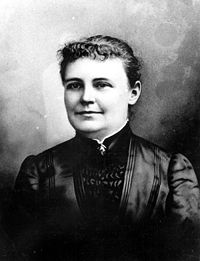
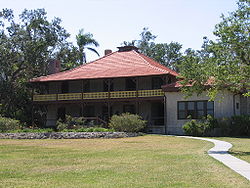
Julia Tuttle
Julia DeForest Tuttle, was an entrepreneur, citrus farmer and businesswoman who was largely responsible for, and the original owner of, the land upon which Miami, Florida, was built...
purchased an enormous citrus
Citrus
Citrus is a common term and genus of flowering plants in the rue family, Rutaceae. Citrus is believed to have originated in the part of Southeast Asia bordered by Northeastern India, Myanmar and the Yunnan province of China...
plantation in the Miami area. Tuttle's husband, Frederick Tuttle, had died in 1886, and she decided to move to South Florida due to the "delicate health" of her children. She and William Brickell tried to get railroad magnate Henry Flagler to expand his rail line, the Florida East Coast Railroad, southward to the area, but he initially declined.
However, in the winter of 1894, Florida was struck by bad weather that destroyed virtually the entire citrus
Citrus
Citrus is a common term and genus of flowering plants in the rue family, Rutaceae. Citrus is believed to have originated in the part of Southeast Asia bordered by Northeastern India, Myanmar and the Yunnan province of China...
crop in the northern half of the state. A few months later on the night of February 7, 1895, Florida was hit by another freeze. That freeze wiped out the remaining crops and the new trees. Unlike the rest of the state, Miami was unaffected, and Tuttle's citrus became the only citrus on the market that year. Tuttle wrote to Flagler again, persuading him to visit the area and to see it for himself, and sent him some of the flowers to show that the area escaped the frost. Flagler did so, and concluded at the end of his first day that the area was ripe for expansion. He made the decision to extend his railroad to Miami and build a resort hotel.
On April 22, 1895, Flagler wrote to Tuttle a long letter recapping her offer of land to him in exchange for extending his railroad to Miami, laying out a city and building a hotel. The terms provided that Tuttle would award Flagler a 100 acre (0.404686 km²) tract of land for the city to grow. Flagler wrote a similar letter to Brickell around that time.
While the railroad's extension to Miami remained unannounced in the spring of 1895, rumors of this possibility continued to multiply, fueling real estate activity in the Biscayne Bay area. The news of the railroad’s extension was officially announced on June 21, 1895. In late September, the work on the railroad began and settlers began pouring into the promised "freeze proof" lands. On October 24, 1895, the contract agreed upon by Flagler and Tuttle was approved.
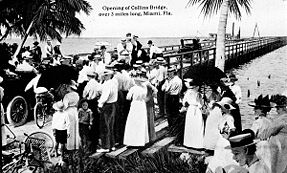
Tent City
A tent city is a temporary housing facility made using tents. Informal tent cities may be set up without authorization by homeless people or protesters. As well, state governments or military organizations set up tent cities to house refugees, evacuees, or soldiers...
and huts in the wilderness, which had no streets and few cleared paths. These men were primarily victims of the freeze, which had left both money and work scarce.
On February 1, 1896, Tuttle fulfilled the first part of her agreement with Flagler by signing two deeds to transfer land for his hotel and the 100 acre (0.404686 km²) of land near the hotel site to him. The titles to the Brickell and Tuttle properties were based on early Spanish land grants and had to be determined to be clear of conflict before the marketing of the Miami lots began. On March 3, Flagler hired John Sewell from West Palm Beach
West Palm Beach, Florida
West Palm Beach, is a city located on the Atlantic coast in southeastern Florida and is the most populous city in and county seat of Palm Beach County, the third most populous county in Florida with a 2010 population of 1,320,134. The city is also the oldest incorporated municipality in South Florida...
to begin work on the town, while more people came into Miami. On April 7, 1896, the railroad tracks finally reached Miami, and the first train arrived on April 13. It was a special, unscheduled train, and Flagler was on board. The train returned to St. Augustine
St. Augustine, Florida
St. Augustine is a city in the northeast section of Florida and the county seat of St. Johns County, Florida, United States. Founded in 1565 by Spanish explorer and admiral Pedro Menéndez de Avilés, it is the oldest continuously occupied European-established city and port in the continental United...
later that night. The first regularly scheduled train arrived on the night of April 15. The first week of train service provided only for freight trains, and passenger service did not begin until a week later, on April 22.
On July 28, 1896, the incorporation meeting to make Miami a city took place. The right to vote was restricted to all men who resided in Miami or Dade County. Joseph A. McDonald, Flagler’s chief of construction on the Royal Palm Hotel
Royal Palm Hotel (Miami)
The Royal Palm Hotel was a large resort hotel built by well-known railroad magnate Henry Flagler in Miami, Florida. Opening its doors in 1897, the Royal Palm Hotel was one of the first area hotels in Miami. Five stories tall with a sixth-floor salon, the Royal Palm Hotel featured the city's first...
, was elected chairman of the meeting. After ensuring that the required number of voters was present, the motion was made to incorporate and organize a city government under the corporate name of "The City of Miami," with the boundaries as proposed. John B. Reilly
John B. Reilly
John B. Reilly was the first Mayor of Miami.John B. Reilly was born in Connecticut on May 18, 1870. In 1886 he became a shipping clerk in Branford, Connecticut. He moved to Florida in 1893 accepting the position of bookkeeper and cashier for the firm of McQuire & McDonald, who contracted with...
, who headed Flagler's Fort Dallas land company, was the first elected mayor.
Initially, most residents wanted to name the city "Flagler". However, Henry Flagler was adamant that the new city would not be named after him. So on July 28, 1896, the City of Miami, named after the Miami River
Miami River (Florida)
The Miami River is a river in the United States state of Florida that drains out of the Everglades and runs through the Downtown and the city of Miami. The long river flows from the terminus of the Miami Canal at Miami International Airport to Biscayne Bay...
, was incorporated with 502 voters, including 100 registered black
African American
African Americans are citizens or residents of the United States who have at least partial ancestry from any of the native populations of Sub-Saharan Africa and are the direct descendants of enslaved Africans within the boundaries of the present United States...
voters. The blacks provided the primary labor force for the building of Miami. Clauses in land deeds confined blacks to the northwest section of Miami, which became known as "Colored Town" (today's Overtown).
1900s to 1930s: The Magic City
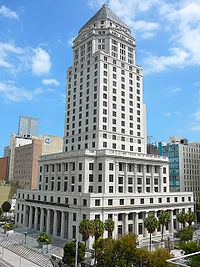

World War II
World War II, or the Second World War , was a global conflict lasting from 1939 to 1945, involving most of the world's nations—including all of the great powers—eventually forming two opposing military alliances: the Allies and the Axis...
was astronomical. In 1900, 1,681 people lived in Miami, Florida; in 1910, there were 5,471 people; and in 1920, there were 29,549 people. As thousands of people moved to the area in the early 20th century, the need for more land quickly became apparent. Up until then, the Florida Everglades
Everglades
The Everglades are subtropical wetlands in the southern portion of the U.S. state of Florida, comprising the southern half of a large watershed. The system begins near Orlando with the Kissimmee River, which discharges into the vast but shallow Lake Okeechobee...
only extended to three miles (5 km) west of Biscayne Bay. Beginning in 1906, canal
Canal
Canals are man-made channels for water. There are two types of canal:#Waterways: navigable transportation canals used for carrying ships and boats shipping goods and conveying people, further subdivided into two kinds:...
s were made to remove some of the water from those lands. Miami Beach
Miami Beach, Florida
Miami Beach is a coastal resort city in Miami-Dade County, Florida, United States, incorporated on March 26, 1915. The municipality is located on a barrier island between the Atlantic Ocean and Biscayne Bay, the latter which separates the Beach from Miami city proper...
was developed in 1913 when a two-mile (3 km) wooden bridge built by John Collins was completed. During the early 1920s, the authorities of Miami allowed gambling
Gambling
Gambling is the wagering of money or something of material value on an event with an uncertain outcome with the primary intent of winning additional money and/or material goods...
and were very lax in regulating Prohibition
Prohibition
Prohibition of alcohol, often referred to simply as prohibition, is the practice of prohibiting the manufacture, transportation, import, export, sale, and consumption of alcohol and alcoholic beverages. The term can also apply to the periods in the histories of the countries during which the...
, so thousands of people migrated from the northern United States to the Miami region. This caused the first Florida construction boom
Florida land boom of the 1920s
The Florida land boom of the 1920s was Florida's first real estate bubble, which burst in 1925, leaving behind entire new cities and the remains of failed development projects such as Aladdin City in south Miami-Dade County and Isola di Lolando in north Biscayne Bay...
and many high-rise buildings were built: some early developments were razed after their initial construction to construct larger buildings. The population of Miami doubled from 1920 to 1923. The nearby areas of Lemon City, Coconut Grove and Allapattah were annexed in the fall of 1925, creating the Greater Miami area.
This speculation boom started to falter because of building construction delays. The transport system was constantly overloaded with bulky building materials. On January 10, 1926 the Prinz Valdemar, an old Danish warship on its way to becoming a floating hotel, ran aground and blocked Miami Harbor for nearly a month. Already overloaded, the three major railway companies soon declared an embargo
Embargo
An embargo is the partial or complete prohibition of commerce and trade with a particular country, in order to isolate it. Embargoes are considered strong diplomatic measures imposed in an effort, by the imposing country, to elicit a given national-interest result from the country on which it is...
on all incoming goods except food. The cost of living had skyrocketed and finding an affordable place to live was nearly impossible. This economic bubble
Economic bubble
An economic bubble is "trade in high volumes at prices that are considerably at variance with intrinsic values"...
was already collapsing when the catastrophic Great Miami Hurricane
1926 Miami Hurricane
The 1926 Miami hurricane was a Category 4 hurricane that devastated Miami in September 1926. The storm also caused significant damage in the Florida Panhandle, the U.S. state of Alabama, and the Bahamas...
in 1926 ended what was left of the boom. According to the Red Cross, there were 373 fatalities. Other estimates vary, since there were a large number of people listed as "missing". Between 25,000 and 50,000 people were left homeless in the Miami area. The Category 4 storm was the 12th most costly and 12th most deadly to strike the United States during the 20th century. The Great Depression
Great Depression
The Great Depression was a severe worldwide economic depression in the decade preceding World War II. The timing of the Great Depression varied across nations, but in most countries it started in about 1929 and lasted until the late 1930s or early 1940s...
followed, in which more than sixteen thousand people in Miami became unemployed. A Civilian Conservation Corps
Civilian Conservation Corps
The Civilian Conservation Corps was a public work relief program that operated from 1933 to 1942 in the United States for unemployed, unmarried men from relief families, ages 18–25. A part of the New Deal of President Franklin D...
camp was opened in the area.
In the mid-1930s, the Art Deco
Art Deco
Art deco , or deco, is an eclectic artistic and design style that began in Paris in the 1920s and flourished internationally throughout the 1930s, into the World War II era. The style influenced all areas of design, including architecture and interior design, industrial design, fashion and...
district of Miami Beach
Miami Beach, Florida
Miami Beach is a coastal resort city in Miami-Dade County, Florida, United States, incorporated on March 26, 1915. The municipality is located on a barrier island between the Atlantic Ocean and Biscayne Bay, the latter which separates the Beach from Miami city proper...
was developed. On February 15, 1933, an assassination attempt was made on President-elect Franklin D. Roosevelt
Franklin D. Roosevelt
Franklin Delano Roosevelt , also known by his initials, FDR, was the 32nd President of the United States and a central figure in world events during the mid-20th century, leading the United States during a time of worldwide economic crisis and world war...
by Giuseppe Zangara
Giuseppe Zangara
Giuseppe Zangara was the assassin of Chicago mayor Anton Cermak, though United States President–elect Franklin Delano Roosevelt may have been his intended target. Roosevelt escaped injury, but five people were shot including Cermak.- Early life :Zangara was born in Ferruzzano, Calabria, Italy...
, an Italian anarchist, while Roosevelt was giving a speech in Miami's Bayfront Park
Bayfront Park
Bayfront Park is a public, urban park in Downtown Miami, Florida on Biscayne Bay.-History:The park began construction in 1924 under the design plans of Warren Henry Manning and officially opened in March 1925. Beginning in 1980, it underwent a major redesign by Japanese-American modernist artist...
. Mayor Anton Cermak
Anton Cermak
Anton Joseph Cermak was the mayor of Chicago, Illinois, from 1931 until his assassination by Giuseppe Zangara in 1933.-Early life and career:...
of Chicago, who was shaking hands with Roosevelt, was shot and died two weeks later. Four other people were wounded, but President-elect Roosevelt was not harmed. At his sentencing Zangara said, "I decide to kill him and make him suffer. I want to make it 50-50. Since my stomach hurt I want to make even with capitalists by kill the President. My stomach hurt long time." Zangara was quickly tried for Cermak's murder and was executed by the electric chair on March 20, 1933 in Raiford, Florida
Raiford, Florida
Raiford is a town in Union County, Florida, United States. The population was 187 at the 2000 census. As of 2004, the population recorded by the U.S...
.
1940s: World War II
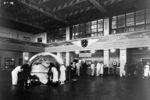
U-boat
U-boat is the anglicized version of the German word U-Boot , itself an abbreviation of Unterseeboot , and refers to military submarines operated by Germany, particularly in World War I and World War II...
s attacked several American ships. Among the American ships was the Portero del Llano, which was attacked by a German submarine and sank within sight of Miami Beach in May 1942. To defend against those U-boats, Miami was placed in two military districts, the Eastern Defense Command
Eastern Defense Command
Eastern Defense Command was established on 17 March 1941 as the command formation of the U.S. Army responsible for coordinating the defense of the Atlantic Coast region of the United States. EDC replaced the existing Northeast Defense Command. A second major responsibility of EDC was the training...
and the Seventh Naval District, which was designed to defend against those attacks.
In February 1942, the Gulf Sea Frontier was established to help guard the waters around Florida, and by June of that year, more attacks forced military leaders in Washington D.C. to increase the numbers of ships and men of the army group. They also had moved the headquarters from Key West
Key West, Florida
Key West is a city in Monroe County, Florida, United States. The city encompasses the island of Key West, the part of Stock Island north of U.S. 1 , Sigsbee Park , Fleming Key , and Sunset Key...
to the DuPont building in Miami, taking advantage of its location at the southeastern corner of the U.S. As the war against the U-boats grew stronger, more military bases sprang up in the Miami area. The U.S. Navy
United States Navy
The United States Navy is the naval warfare service branch of the United States Armed Forces and one of the seven uniformed services of the United States. The U.S. Navy is the largest in the world; its battle fleet tonnage is greater than that of the next 13 largest navies combined. The U.S...
took control of Miami's docks and established air stations at the Opa-locka Airport
Opa-locka Airport
Opa-locka Airport , also known as Opa-locka Executive Airport, is a general aviation airport and joint civil-military airfield 10 miles north of Downtown Miami, primarily in metropolitan Miami, Florida, United States, with a portion within the city proper of Opa-locka.The airport's control tower...
and in Dinner Key. The Air Force also set up bases in the local airports in the Miami area.
Many military schools, supply, and communications facilities were established in the area. Rather than building large army bases to train the men needed to fight the war, the Army and Navy came to South Florida and took over hotels for barracks, movie theaters for classrooms, and local beaches and golf courses for training purposes. Eventually, over five hundred thousand enlisted men and fifty thousand officers trained in South Florida. After the end of the war, many servicemen and women returned to Miami, pushing the population up to almost half a million by 1950.
First Cuban wave
Following the 1959 revolutionCuban Revolution
The Cuban Revolution was an armed revolt by Fidel Castro's 26th of July Movement against the regime of Cuban dictator Fulgencio Batista between 1953 and 1959. Batista was finally ousted on 1 January 1959, and was replaced by a revolutionary government led by Castro...
that unseated Fulgencio Batista
Fulgencio Batista
Fulgencio Batista y Zaldívar was the United States-aligned Cuban President, dictator and military leader who served as the leader of Cuba from 1933 to 1944 and from 1952 to 1959, before being overthrown as a result of the Cuban Revolution....
and brought Fidel Castro
Fidel Castro
Fidel Alejandro Castro Ruz is a Cuban revolutionary and politician, having held the position of Prime Minister of Cuba from 1959 to 1976, and then President from 1976 to 2008. He also served as the First Secretary of the Communist Party of Cuba from the party's foundation in 1961 until 2011...
to power, most Cubans who were living in Miami went back to Cuba
Cuba
The Republic of Cuba is an island nation in the Caribbean. The nation of Cuba consists of the main island of Cuba, the Isla de la Juventud, and several archipelagos. Havana is the largest city in Cuba and the country's capital. Santiago de Cuba is the second largest city...
. That soon changed, and many middle class and upper class Cubans moved to Florida en masse with few possessions. Some Miamians were upset about this, especially the African American
African American
African Americans are citizens or residents of the United States who have at least partial ancestry from any of the native populations of Sub-Saharan Africa and are the direct descendants of enslaved Africans within the boundaries of the present United States...
s, as Cuban workers were replacing them at jobs. The school system struggled to educate the thousands of Spanish-speaking Cuban children. Many of those Cubans later participated in the failed Bay of Pigs Invasion
Bay of Pigs Invasion
The Bay of Pigs Invasion was an unsuccessful action by a CIA-trained force of Cuban exiles to invade southern Cuba, with support and encouragement from the US government, in an attempt to overthrow the Cuban government of Fidel Castro. The invasion was launched in April 1961, less than three months...
. Many Miamians, thinking that World War III (the Cold War
Cold War
The Cold War was the continuing state from roughly 1946 to 1991 of political conflict, military tension, proxy wars, and economic competition between the Communist World—primarily the Soviet Union and its satellite states and allies—and the powers of the Western world, primarily the United States...
) was looming ahead, left the city, while others started building bomb shelter
Bomb shelter
A bomb shelter is any kind of a civil defense structure designed to provide protection against the effects of a bomb.-Types of shelter:Different kinds of bomb shelters are configured to protect against different kinds of attack and strengths of hostile explosives. For example, an Air-raid shelter...
s and stocking up on food and bottled water. Many of Miami's Cuban refugees realized for the first time that it would be a long time before they would get back to Cuba. In 1965 alone, 100,000 Cubans packed into the twice daily "freedom flights" from Havana
Havana
Havana is the capital city, province, major port, and leading commercial centre of Cuba. The city proper has a population of 2.1 million inhabitants, and it spans a total of — making it the largest city in the Caribbean region, and the most populous...
to Miami. Most of the exiles settled into the Riverside neighborhood, which began to take on the new name of "Little Havana
Little Havana
Little Havana is a neighborhood of Miami, Florida, United States. Home to many Cuban immigrant residents, Little Havana is named after Havana, the capital and largest city in Cuba. The approximate boundaries are the Miami River , SW 16th Street , SR 9/West 27th Avenue and I-95...
". This area emerged as a predominantly Spanish-speaking
Spanish language
Spanish , also known as Castilian , is a Romance language in the Ibero-Romance group that evolved from several languages and dialects in central-northern Iberia around the 9th century and gradually spread with the expansion of the Kingdom of Castile into central and southern Iberia during the...
community, and Spanish speakers elsewhere in the city could conduct most of their daily business in their native tongue. By the end of the 1960s, more than four hundred thousand Cuban refugees were living in Miami-Dade County.
In the 1960s and 1970s, the Attorney General's authority was used to grant parole, or special permission, to allow Cubans to enter the country. However, parole only allows an individual permission to enter the country, not to stay permanently. In the case of Cubans, the Cuban Adjustment Act of 1966 resolved this dilemma. The Act provides that the immigration status of any Cuban who arrived since 1959 and has been physically present in the United States for at least a year "may be adjusted by the Attorney General to that of an alien lawfully admitted for permanent residence" (green card
United States Permanent Resident Card
United States lawful permanent residency refers to a person's immigration status: the person is authorized to live and work in the United States of America on a permanent basis....
holder). The individual must be admissible to the United States (i.e., not disqualified on criminal or other grounds).
Civil Rights Movement
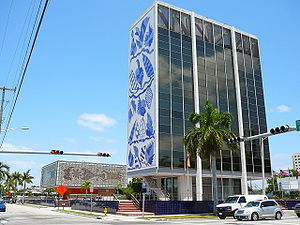
Caribbean
The Caribbean is a crescent-shaped group of islands more than 2,000 miles long separating the Gulf of Mexico and the Caribbean Sea, to the west and south, from the Atlantic Ocean, to the east and north...
population.
In the 1970s, Miami was a news leader, resulting from response to a Dade County (now Miami-Dade) ordinance protecting individuals on the basis of sexual orientation
Sexual orientation
Sexual orientation describes a pattern of emotional, romantic, or sexual attractions to the opposite sex, the same sex, both, or neither, and the genders that accompany them. By the convention of organized researchers, these attractions are subsumed under heterosexuality, homosexuality,...
. Opposition to this ordinance was led by Florida orange juice
Orange juice
Orange juice is a popular beverage made from oranges. It is made by extraction from the fresh fruit, by desiccation and subsequent reconstitution of dried juice, or by concentration of the juice and the subsequent addition of water to the concentrate...
spokeswoman, Anita Bryant
Anita Bryant
Anita Jane Bryant is an American singer, former Miss Oklahoma beauty pageant winner, and gay rights opponent. She scored four Top 40 hits in the United States in the late 1950s and early 1960s, including "Paper Roses", which reached #5...
.
In December 1979, police officers pursued motorcyclist Arthur McDuffie
Arthur McDuffie
Arthur McDuffie was an African American who died as a result of injuries suffered at the hands of five white Miami-Dade police officers after a traffic stop was conducted. He had led the officers on a high-speed chase on his motorcycle, and was driving with a suspended license. The officers were...
in a high-speed chase after McDuffie made a provocative gesture towards a police officer. The officers claimed that the chase ended when McDuffie crashed his motorcycle
Motorcycle
A motorcycle is a single-track, two-wheeled motor vehicle. Motorcycles vary considerably depending on the task for which they are designed, such as long distance travel, navigating congested urban traffic, cruising, sport and racing, or off-road conditions.Motorcycles are one of the most...
and died. The coroner's report concluded otherwise. One of the officers testified that McDuffie fell off of his bike on an Interstate 95
Interstate 95 in Florida
Interstate 95 is the main Interstate Highway on the east coast of the United States; it serves the Atlantic coast of Florida. It begins at a partial interchange with U.S. Highway 1 just south of downtown Miami, and heads north past Daytona Beach and Jacksonville to the Georgia state line at the St...
on-ramp. When the police reached him he was injured but okay. The officers removed his helmet, beat him to death with their batons, put his helmet back on, and called an ambulance claiming there had been a motorcycle accident. Eula McDuffie, the victim's mother, said to the Miami Herald a few days later, "They beat my son like a dog. They beat him just because he was riding a motorcycle and because he was black." A jury acquitted the officers after a brief deliberation.
After learning of the verdict of the McDuffie case, one of the worst riots in the history of the United States, the Liberty City Riots, broke out. By the time the rioting ceased three days later, over 850 people had been arrested, and at least 18 people had died. Property damage was estimated at around one hundred million dollars. One more person, a sixty-five year old woman named Mildred Penton died after being in a coma for five weeks after being struck in the head with a brick.
In March 1980, the first black Dade County schools superintendent, Dr. Johnny L. Jones
Johnny L. Jones
Johnny L. Jones was the former Miami-Dade Schools superintendent between 1977 and 1979, who was the first black person to hold the post in Miami-Dade....
, had been convicted on grand theft charges linked to gold-plated plumbing. His conviction was overturned on appeal, and on July 3, 1986, the state attorney Janet Reno
Janet Reno
Janet Wood Reno is a former Attorney General of the United States . She was nominated by President Bill Clinton on February 11, 1993, and confirmed on March 11...
announced that Jones would not be retried on those charges. However, in a separate case, he was convicted on misdemeanor charges of soliciting perjury and witness tampering, and received a two-year jail sentence.
Later immigration
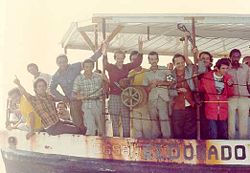
Mariel boatlift
The Mariel boatlift was a mass emigration of Cubans who departed from Cuba's Mariel Harbor for the United States between April 15 and October 31, 1980....
of 1980 brought 150,000 Cubans to Miami, the largest in civilian history. Unlike the previous exodus of the 1960s, most of the Cuban refugees arriving were poor. During this time, many of the middle class non-Hispanic whites in the community left the city, often referred to as the "white flight
White flight
White flight has been a term that originated in the United States, starting in the mid-20th century, and applied to the large-scale migration of whites of various European ancestries from racially mixed urban regions to more racially homogeneous suburban or exurban regions. It was first seen as...
." In 1960, Miami was 90% non-Hispanic white; by 1990, it was only about 10% non-Hispanic white.
In the 1980s, Miami started to see an increase in immigrants from other nations such as Haiti. As the Haitian population grew, the area known today as Little Haiti
Little Haiti
Little Haiti or La Petite Haïti, and traditionally known as Lemon City, is a neighborhood in Miami, Florida, United States known as a traditional center for Haitian immigrants, and Francophone culture in the city.-Lemon City, early farming days:...
emerged, centered on Northeast Second Avenue and 54th Street. In 1985, Xavier Suarez
Xavier Suarez
Xavier L. Suarez was the first native born Cuban mayor of Miami.Suarez attended the Colegio de Belen but graduated from St. Anselm's Abbey School in 1967, earned a degree in engineering from Villanova University in 1971, and later studied government and law at Harvard University...
was elected as Mayor of Miami, becoming the first Cuban mayor of a major city. In the 1990s, the presence of Haitians was acknowledged with Haitian Creole language
Haitian Creole language
Haitian Creole language , often called simply Creole or Kreyòl, is a language spoken in Haiti by about twelve million people, which includes all Haitians in Haiti and via emigration, by about two to three million speakers residing in the Bahamas, Cuba, Canada, France, Cayman Islands, French...
signs in public places and ballots during voting.
Another major Cuban exodus occurred in 1994. To prevent it from becoming another Mariel Boatlift, the Clinton Administration
Bill Clinton
William Jefferson "Bill" Clinton is an American politician who served as the 42nd President of the United States from 1993 to 2001. Inaugurated at age 46, he was the third-youngest president. He took office at the end of the Cold War, and was the first president of the baby boomer generation...
announced a significant change in U.S. policy. In a controversial action, the administration announced that Cubans interdicted at sea would not be brought to the United States but instead would be taken by the Coast Guard to U.S. military installations at Guantanamo Bay
Guantanamo Bay Naval Base
Guantanamo Bay Naval Base is located on of land and water at Guantánamo Bay, Cuba which the United States leased for use as a coaling station following the Cuban-American Treaty of 1903. The base is located on the shore of Guantánamo Bay at the southeastern end of Cuba. It is the oldest overseas...
or to Panama
Panama
Panama , officially the Republic of Panama , is the southernmost country of Central America. Situated on the isthmus connecting North and South America, it is bordered by Costa Rica to the northwest, Colombia to the southeast, the Caribbean Sea to the north and the Pacific Ocean to the south. The...
. During an eight-month period beginning in the summer of 1994, over 30,000 Cubans and more than 20,000 Haitians were interdicted and sent to live in camps outside the United States.
On September 9, 1994, the United States and Cuba agreed to normalize migration between the two countries. The agreement codified the new U.S. policy of placing Cuban refugees in safe havens outside the United States, while obtaining a commitment from Cuba to discourage Cubans from sailing to America. In addition, the United States committed to admitting a minimum of 20,000 Cuban immigrants per year. That number is in addition to the admission of immediate relatives of U.S. citizens.
On May 2, 1995, a second agreement with the Castro government paved the way for the admission to the United States of the Cubans housed at Guantanamo, who were counted primarily against the first year of the 20,000 annual admissions committed to by the Clinton Administration. It also established a new policy of directly repatriating Cubans interdicted at sea to Cuba. In the agreement, the Cuban government pledged not to retaliate against those who were repatriated.
These agreements with the Cuban government led to what has been called the Wet Foot-Dry Foot Policy, whereby Cubans who made it to shore could stay in the United States – likely becoming eligible to adjust to permanent residence under the Cuban Adjustment Act. However, those who do not make it to dry land ultimately are repatriated unless they can demonstrate a well-founded fear of persecution if returned to Cuba. Because it was stated that Cubans were escaping for political reasons, this policy did not apply to Haitians, who the government claimed were seeking asylum for economic reasons.
Since then, the Latin and Caribbean-friendly atmosphere in Miami has made it a popular destination for tourists and immigrants from all over the world, and the third-biggest immigration port in the country after New York City
New York City
New York is the most populous city in the United States and the center of the New York Metropolitan Area, one of the most populous metropolitan areas in the world. New York exerts a significant impact upon global commerce, finance, media, art, fashion, research, technology, education, and...
and Los Angeles
Los Angeles, California
Los Angeles , with a population at the 2010 United States Census of 3,792,621, is the most populous city in California, USA and the second most populous in the United States, after New York City. It has an area of , and is located in Southern California...
. In addition, large immigrant communities have settled in Miami from around the globe, including Europe, Africa, and Asia. The majority of Miami's European immigrant communities are recent immigrants, many living in the city seasonally, with a high disposable income.
Growth as a global city
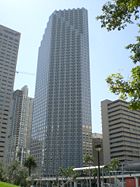
Transshipment
Transshipment or Transhipment is the shipment of goods or containers to an intermediate destination, and then from there to yet another destination....
point for cocaine
Cocaine
Cocaine is a crystalline tropane alkaloid that is obtained from the leaves of the coca plant. The name comes from "coca" in addition to the alkaloid suffix -ine, forming cocaine. It is a stimulant of the central nervous system, an appetite suppressant, and a topical anesthetic...
from Colombia
Colombia
Colombia, officially the Republic of Colombia , is a unitary constitutional republic comprising thirty-two departments. The country is located in northwestern South America, bordered to the east by Venezuela and Brazil; to the south by Ecuador and Peru; to the north by the Caribbean Sea; to the...
, Bolivia
Bolivia
Bolivia officially known as Plurinational State of Bolivia , is a landlocked country in central South America. It is the poorest country in South America...
, and Peru
Peru
Peru , officially the Republic of Peru , is a country in western South America. It is bordered on the north by Ecuador and Colombia, on the east by Brazil, on the southeast by Bolivia, on the south by Chile, and on the west by the Pacific Ocean....
. The drug industry brought billions of dollars into Miami, which were quickly funneled through front organization
Front organization
A front organization is any entity set up by and controlled by another organization, such as intelligence agencies, organized crime groups, banned organizations, religious or political groups, advocacy groups, or corporations...
s into the local economy. Luxury car dealerships, five-star hotels, condominium developments, swanky nightclubs, major commercial developments and other signs of prosperity began rising all over the city. As the money arrived, so did a violent crime wave that lasted through the early 1990s. The popular television program Miami Vice
Miami Vice
Miami Vice is an American television series produced by Michael Mann for NBC. The series starred Don Johnson and Philip Michael Thomas as two Metro-Dade Police Department detectives working undercover in Miami. It ran for five seasons on NBC from 1984–1989...
, which dealt with counter-narcotics agents in an idyllic upper-class rendition of Miami, spread the city's image as one of America's most glamorous subtropical
Subtropics
The subtropics are the geographical and climatical zone of the Earth immediately north and south of the tropical zone, which is bounded by the Tropic of Cancer and the Tropic of Capricorn, at latitudes 23.5°N and 23.5°S...
paradises.
During the 1980s and early 1990s, many noted people visited Miami. Pope John Paul II
Pope John Paul II
Blessed Pope John Paul II , born Karol Józef Wojtyła , reigned as Pope of the Catholic Church and Sovereign of Vatican City from 16 October 1978 until his death on 2 April 2005, at of age. His was the second-longest documented pontificate, which lasted ; only Pope Pius IX ...
visited in November 1987, and held an open-air mass
Mass (liturgy)
"Mass" is one of the names by which the sacrament of the Eucharist is called in the Roman Catholic Church: others are "Eucharist", the "Lord's Supper", the "Breaking of Bread", the "Eucharistic assembly ", the "memorial of the Lord's Passion and Resurrection", the "Holy Sacrifice", the "Holy and...
for 150,000 people in Tamiami Park
Tamiami Park
Tamiami Park is a public urban park in metropolitan Miami, just south of the Modesto Maidique campus of Florida International University.-Background:...
. Queen Elizabeth II
Elizabeth II of the United Kingdom
Elizabeth II is the constitutional monarch of 16 sovereign states known as the Commonwealth realms: the United Kingdom, Canada, Australia, New Zealand, Jamaica, Barbados, the Bahamas, Grenada, Papua New Guinea, the Solomon Islands, Tuvalu, Saint Lucia, Saint Vincent and the Grenadines, Belize,...
and three United States presidents
President of the United States
The President of the United States of America is the head of state and head of government of the United States. The president leads the executive branch of the federal government and is the commander-in-chief of the United States Armed Forces....
also visited Miami. Among them was Ronald Reagan
Ronald Reagan
Ronald Wilson Reagan was the 40th President of the United States , the 33rd Governor of California and, prior to that, a radio, film and television actor....
, who had a street named after him in Little Havana
Little Havana
Little Havana is a neighborhood of Miami, Florida, United States. Home to many Cuban immigrant residents, Little Havana is named after Havana, the capital and largest city in Cuba. The approximate boundaries are the Miami River , SW 16th Street , SR 9/West 27th Avenue and I-95...
. Nelson Mandela
Nelson Mandela
Nelson Rolihlahla Mandela served as President of South Africa from 1994 to 1999, and was the first South African president to be elected in a fully representative democratic election. Before his presidency, Mandela was an anti-apartheid activist, and the leader of Umkhonto we Sizwe, the armed wing...
's 1989 visit to the city was marked by ethnic tensions. Mandela had praised Cuban leader Fidel Castro for his anti-apartheid support on ABC News
ABC News
ABC News is the news gathering and broadcasting division of American broadcast television network ABC, a subsidiary of The Walt Disney Company...
' Nightline. Because of this, the city withdrew its official greeting and no high-ranking official welcomed him. That led to a boycott by the local African American community of all Miami tourist and convention facilities until Mandela received an official greeting. However, all efforts to resolve it failed for months, resulting in an estimated loss of over $
United States dollar
The United States dollar , also referred to as the American dollar, is the official currency of the United States of America. It is divided into 100 smaller units called cents or pennies....
10 million.
1990s
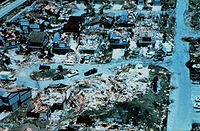
Hurricane Andrew
Hurricane Andrew was the third Category 5 hurricane to make landfall in the United States, after the Labor Day Hurricane of 1935 and Hurricane Camille in 1969. Andrew was the first named storm and only major hurricane of the otherwise inactive 1992 Atlantic hurricane season...
caused more than $20 billion in damage just south of the Miami-Dade area in 1992.
Several financial scandals involving the Mayor's office and City Commission during the 1980s and 1990s left Miami with the title of the United States' 4th poorest city by 1996. With a budget shortfall of $68 Million and its municipal bond
Municipal bond
A municipal bond is a bond issued by a city or other local government, or their agencies. Potential issuers of municipal bonds includes cities, counties, redevelopment agencies, special-purpose districts, school districts, public utility districts, publicly owned airports and seaports, and any...
s given a junk bond rating by Wall Street
Wall Street
Wall Street refers to the financial district of New York City, named after and centered on the eight-block-long street running from Broadway to South Street on the East River in Lower Manhattan. Over time, the term has become a metonym for the financial markets of the United States as a whole, or...
, Miami became Florida's first city to have a state appointed oversight board assigned to it in 1997. In the same year, city voters rejected a resolution to dissolve the city and make it one entity with Dade County. The City's financial problems continued until political outsider Manny Diaz was elected Mayor of Miami in 2001.
2000s: A new era
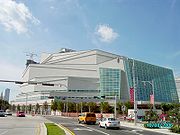
Elián González
The custody and immigration status of a young Cuban boy, Elián González , was at the center of a heated 2000 controversy involving the governments of Cuba and the United States, González's father, Juan Miguel González Quintana, González's other relatives in Miami, Florida, and in Cuba, and Miami's...
uproar was a heated custody and immigration battle in the Miami area in 2000. The controversy concerned six-year-old Elián González, who was rescued from the waters off the coast of Miami. The U.S.
Federal government of the United States
The federal government of the United States is the national government of the constitutional republic of fifty states that is the United States of America. The federal government comprises three distinct branches of government: a legislative, an executive and a judiciary. These branches and...
and the Cuban governments, his father Juan Miguel González, his Miami relatives, and the Cuban-American community of Miami were involved. The climactic stage of this prolonged battle was the April 22, 2000, seizure of Elián by federal agents, which drew the criticism of many in the Cuban-American community. During the controversy, Alex Penelas
Alex Penelas
Alexander "Alex" Penelas is the former mayor of Miami-Dade County, Florida.-Schooling and personal life:Penelas, an American of Cuban descent, attended college at St. Thomas University...
, the mayor of Miami-Dade County at the time, vowed that he would do nothing to assist the Bill Clinton
Bill Clinton
William Jefferson "Bill" Clinton is an American politician who served as the 42nd President of the United States from 1993 to 2001. Inaugurated at age 46, he was the third-youngest president. He took office at the end of the Cold War, and was the first president of the baby boomer generation...
administration and federal authorities in their bid to return the six-year-old boy to Cuba. Tens of thousands of protesters, many of whom were outraged at the raid, poured out into the streets of Little Havana
Little Havana
Little Havana is a neighborhood of Miami, Florida, United States. Home to many Cuban immigrant residents, Little Havana is named after Havana, the capital and largest city in Cuba. The approximate boundaries are the Miami River , SW 16th Street , SR 9/West 27th Avenue and I-95...
and demonstrated. Car horns blared, demonstrators turned over signs, trash cans, and newspaper racks and some small fires were started. Rioters jammed a 10-block area of Little Havana. Shortly afterwards, many Miami businesses closed, as their owners and managers participated in a short, one-day boycott against the city, attempting to affect its tourism industry. Employees of airlines, cruise lines, hotels, car rental companies, and major retailers participated in the boycott. Elián González returned to Cuba with his father on June 28, 2000.
The controversial Free Trade Area of the Americas
Free Trade Area of the Americas
The Free Trade Area of the Americas , , ) was a proposed agreement to eliminate or reduce the trade barriers among all countries in the Americas but Cuba. In the last round of negotiations, trade ministers from 34 countries met in Miami, United States, in November 2003 to discuss the proposal...
negotiations occurred in 2003. It was a proposed agreement to reduce trade barriers while increasing intellectual property rights. During the 2003 meeting in Miami, the Free Trade Area of the Americas was met by heavy opposition from anti-corporatization and anti-globalization protests.
On June 27, 2005, the popular ex-city commissioner Arthur Teele
Arthur Teele
Arthur "Art" Teele was an American lawyer and politician who belonged to the Republican Party. Born into a wealthy black family in Florida, Teele received an excellent education and became a highly respected officer in the US Army and went on to a very successful career in private practice and...
walked into the main lobby of the Miami Herald headquarters, dropped off a package for columnist Jim DeFede, and told the security guard to tell his wife Stephanie he "loved her" before pulling out a gun and committing suicide
Suicide
Suicide is the act of intentionally causing one's own death. Suicide is often committed out of despair or attributed to some underlying mental disorder, such as depression, bipolar disorder, schizophrenia, alcoholism, or drug abuse...
. His suicide happened the day the alternative weekly Miami New Times
Miami New Times
The Miami New Times is a free weekly newspaper published in Miami and distributed every Thursday. It primarily serves the Miami area and is headquartered near Miami's Design District.-Overview:...
published salacious details of Teele's alleged affairs, including allegations that Teele had sex with a transsexual prostitute and used cocaine. At the time, Teele was being investigated by federal authorities for fraud
Fraud
In criminal law, a fraud is an intentional deception made for personal gain or to damage another individual; the related adjective is fraudulent. The specific legal definition varies by legal jurisdiction. Fraud is a crime, and also a civil law violation...
and money laundering
Money laundering
Money laundering is the process of disguising illegal sources of money so that it looks like it came from legal sources. The methods by which money may be laundered are varied and can range in sophistication. Many regulatory and governmental authorities quote estimates each year for the amount...
for allegedly taking $59,000 in kickbacks to help a businessman get millions of dollars in contracts at Miami International Airport
Miami International Airport
Miami International Airport , also known as MIA and historically Wilcox Field, is the primary airport serving the South Florida area...
. Teele was suspended from his job in 2004 by Florida governor Jeb Bush
Jeb Bush
John Ellis "Jeb" Bush is an American politician who served as the 43rd Governor of Florida from 1999 to 2007. He is a prominent member of the Bush family: the second son of former President George H. W. Bush and former First Lady Barbara Bush; the younger brother of former President George W...
after being arrested for trying to run a police officer off the road. Teele was also charged in December 2004 with ten counts of unlawful compensation on charges he took $135,000 from TLMC Inc., promising that it would be awarded lucrative contracts to redevelop neighborhoods in Miami. Teele was also found guilty in March 2005 for threatening an undercover detective.
In the latter half of the 2000-2010 decade, Miami has seen an extensive boom of high rise architecture, dubbed a "Miami Manhattanization
Manhattanization
Manhattanization is a neologism coined to describe the construction of many tall or densely situated buildings which transforms the appearance and character of a city. It was a pejorative word used by critics of the highrise buildings built in San Francisco during the 1960s and 1970s, who claimed...
" wave. This has included the construction of many of the tallest buildings in Miami, with nearly 20 of the cities tallest 25 buildings finished after 2005. 2008 and 2007 saw the completion of the largest amount of these buildings. This boom has transformed the look of Downtown Miami, which is now considered to have one of the largest skylines in the United States, ranked behind New York City and Chicago. This boom slowed after the 2008 global financial crisis, with some projects being put on hold and none of the cities tallest buildings being constructed in 2010.
In May 2010, construction began on a major Port of Miami infrastructure project known as the Port of Miami Tunnel, with a total estimated cost of one billion US dollars and an estimated 2014 completion date.
See also
- Downtown Miami Historic DistrictDowntown Miami Historic DistrictThe Downtown Miami Historic District is a U.S. historic district located in Downtown Miami, Florida. The district is bounded by Miami Court, North Third Street, West Third Avenue, and South Second Street. It contains 60 historic buildings...
- History of FloridaHistory of FloridaThe history of Florida can be traced back to when the first Native Americans began to inhabit the peninsula as early as 14,000 years ago. Recorded history begins with the arrival of Europeans to Florida, beginning with the Spanish explorer Juan Ponce de León, who explored the area in 1513...
- List of mayors of Miami
- Lummus Park Historic DistrictLummus Park Historic DistrictThe Lummus Park Historic District or simply Lummus Park, is a U.S. historic district and neighborhood in Miami, Florida. It is roughly bound by Northwest Fifth Street to the north, Flagler Street to the south, Northwest Third Avenue to the east, and the Miami River to the west. On October 25, 2006,...
- National Register of Historic Places listings in Miami, FloridaNational Register of Historic Places listings in Miami, FloridaThis is a list of the National Register of Historic Places listings in Miami, Florida.This is intended to be a complete list of the properties and districts on the National Register of Historic Places in Miami, Florida, United States...

